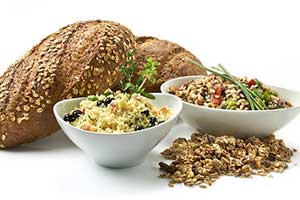- Home
- Editorial
- News
- Practice Guidelines
- Anesthesiology Guidelines
- Cancer Guidelines
- Cardiac Sciences Guidelines
- Critical Care Guidelines
- Dentistry Guidelines
- Dermatology Guidelines
- Diabetes and Endo Guidelines
- Diagnostics Guidelines
- ENT Guidelines
- Featured Practice Guidelines
- Gastroenterology Guidelines
- Geriatrics Guidelines
- Medicine Guidelines
- Nephrology Guidelines
- Neurosciences Guidelines
- Obs and Gynae Guidelines
- Ophthalmology Guidelines
- Orthopaedics Guidelines
- Paediatrics Guidelines
- Psychiatry Guidelines
- Pulmonology Guidelines
- Radiology Guidelines
- Surgery Guidelines
- Urology Guidelines
Its Confirmed- Intake of whole grains can prevent you from diabetes

Intake of whole grain such as rye, oats or wheat, can help in the prevention of type 2 diabetes (T2D), according to a new study published in the The Journal of Nutrition. This comprehensive study is a strong confirmation of previous research findings on the importance of whole grains for T2D prevention.
The study also found that drinking coffee, and avoiding red meat, are other factors that can similarly reduce the risk of T2D.
The ability to use whole grains for the prevention of T2D has been known for a long time. But the role of different wholegrain sources has not been investigated. It has also been unclear how much whole grain is needed to reduce the risk of developing diabetes.
"Most studies similar to ours have previously been conducted in the USA, where people mainly get their wholegrain from wheat," says Dr. Landberg. "We wanted to see if there was a difference between different cereals. One might expect there would be because they contain different types of dietary fiber and bioactive substances, which have been shown to influence risk factors for T2D."
The study used data from a prospective Danish cohort study on diet, cancer, and health. It covered more than 55,000 participants, who were between 50-65 years old when the study started. During the initiation of the cohort study in the early 1990s, healthy participants had filled in detailed forms of their eating habits. Through these, the researchers established the participants' total wholegrain intake per day, which of the most common cereals they got their wholegrain from, (wheat, rye, oats, in grams per day), and the total number, and different types, of wholegrain products (in grams per day) -- rye bread, other wholegrain breads, oatmeal porridge and muesli.
The cohort study was linked with data from Denmark's national diabetes register, to investigate which participants developed T2D during a 15 year period -- which in total was over 7000 people.
The participants were divided into 4 different groups, based on how much wholegrain they reported eating. Those with the highest consumption ate at least 50 grams of whole grain each day. This corresponds to a portion of oatmeal porridge, and one slice of rye bread, for example.
Also Read: Whole Grain May Reduce Risk of Heart Disease
Key Findings:
- Whole-grain intake was associated with an 11% and 7% lower risk of T2D per whole-grain serving (16 g) per day for men and women, respectively [HR (95% CI)—men: 0.89 (0.87, 0.91); women: 0.93 (0.91, 0.96)].
- For men, the intake of all whole-grain cereal types investigated (wheat, rye, oats) was significantly associated with a lower risk of type 2 diabetes, but only wheat and oats intake was significantly associated for women.
- Among the different whole-grain products, rye bread, whole-grain bread, and oatmeal/muesli were significantly associated with a lower risk of type 2 diabetes for both men and women.
- In the group with the highest whole grain intake, the diabetes risk was 34 percent lower for men, and 22 percent lower for women, than in the group with the lowest wholegrain intake.
"Our results are in line with dietary advice, which recommends switching out foods containing white flour for whole grains," says Rikard Landberg. "You get extra health benefits -- white flour has some negative effects on health, while wholegrain has several positive effects, beyond protection against type 2 diabetes."
About Wholegrains
Wholegrains are defined as consisting of all three main components of the grain kernel: endosperm, germ, and bran. Those who avoid all cereals, in an attempt to follow a low carb diet, therefore lose out on the positive health effects of wholegrain, which come principally from the bran and the germ. Rikard Landberg thinks that cereals, and carbohydrates in general, should not be avoided in the diet.
"Carbohydrates are a very varied group of foodstuffs, including sugar, starch, and fiber. We should discuss these more individually, and not throw them together in one group, because they have totally different effects on our physiology and health. When it comes to whole grains, the research results are clear: among the many studies which have been made, in varied groups of people around the world, there hasn't been a single study which has shown negative health effects."
Whole grains consist of all three main components of the grain kernel: endosperm, germ, and bran. It can be both loose grains, and wholegrain flour. Grains such as oatmeal and rye, wheat berries, bulgur, and wholegrain couscous are all whole grains. In bread and pasta, the wholegrain content can vary. Common cereals include wheat, rye, oats, corn, maize, rice, millet, and sorghum.
For more information log on to https://doi.org/10.1093/jn/nxy112

Disclaimer: This site is primarily intended for healthcare professionals. Any content/information on this website does not replace the advice of medical and/or health professionals and should not be construed as medical/diagnostic advice/endorsement or prescription. Use of this site is subject to our terms of use, privacy policy, advertisement policy. © 2020 Minerva Medical Treatment Pvt Ltd